New all-time highs: Construction, Professional & Business Services, Healthcare, Wholesale trade. Layoffs whack Information.
By Wolf Richter for WOLF STREET.
Earlier today, we discussed the overall labor market. But each industry faces its own unique labor market. In some industries, employment has been trucking from all-time high to all-time high, while in other industries, the outlook is darker, usually due to structural changes. So we’ll look at a decade of employment trends in each major industry, based on today’s employment data by the Bureau of Labor Statistics.
The industry categories are by work location. The surveys are sent to employer facilities. The primary activity at that facility determines the industry category. For example, a worker at an Amazon fulfillment center would be under “transportation and warehousing.” It’s not the company that matters, but the work being done at that specific location.
And we use three-month moving averages (3MMA) to iron out the drama of the monthly squiggles.
Construction (all types, from single-family housing to highways).
- Total employment: 8.22 million, new all-time high
- 3MMA growth: +24,000

Manufacturing: After a huge surge out of the pandemic, employment has plateaued for over a year but with a mild upward trend, interrupted by a dip during the auto industry strikes in October. The past five months have all been in a very narrow range around 12.96 million, the highest since before the Great Recession. Manufacturing has continued to automate, requiring fewer but higher-skilled workers, including engineers.
- Total employment: 12.96 million
- 3MMA: -2,000
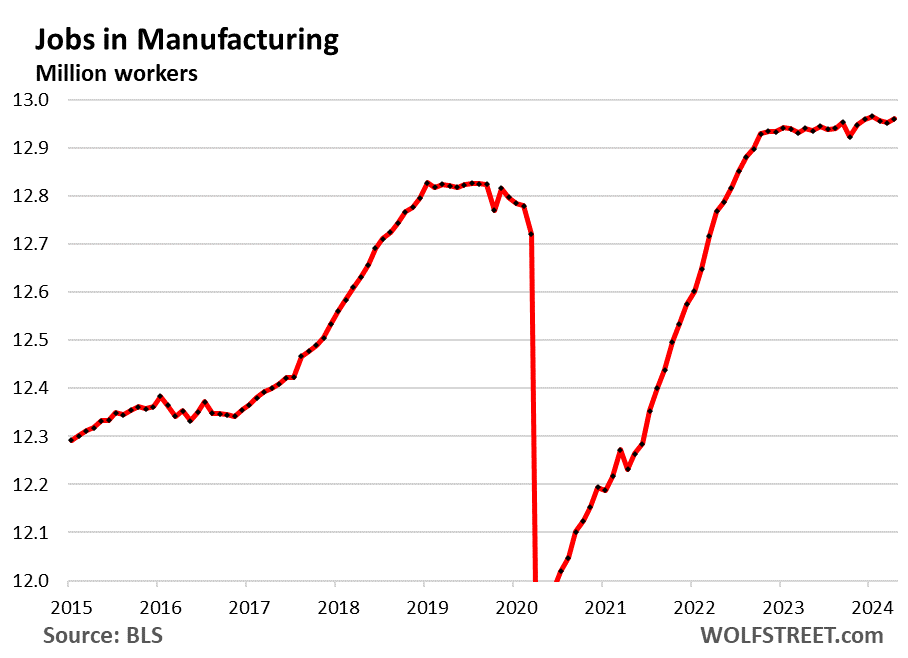
Professional and business services. One of the largest industries by employment, it includes facilities whose employees work primarily in Professional, Scientific, and Technical Services; Management of Companies and Enterprises; Administrative and Support, and Waste Management and Remediation Services. It includes facilities of some tech and social media companies.
The helter-skelter employment growth coming out of the pandemic has definitely slowed, but continues at a subdued pace at nosebleed-high employment levels:
- Total employment: 22.94 million (record)
- 3MMA growth: +4,000

Healthcare and social assistance:
- Total employment: 22.32 million, new high
- 3MMA: +88,000
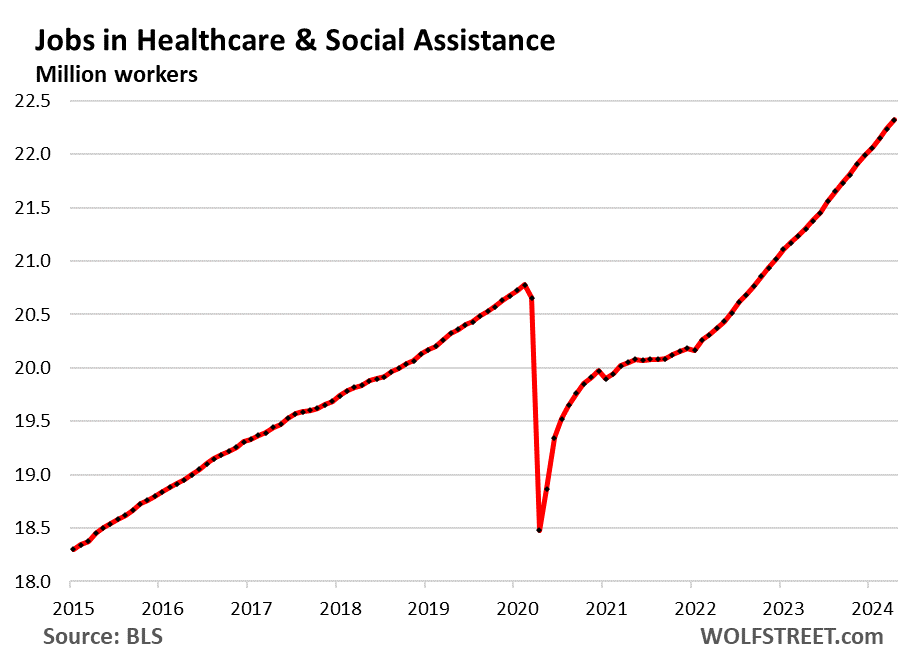
Leisure and hospitality – restaurants, lodging, resorts, etc.
- Total employment: 16.9 million, back at the pre-pandemic high.
- 3MMA growth: +28,000
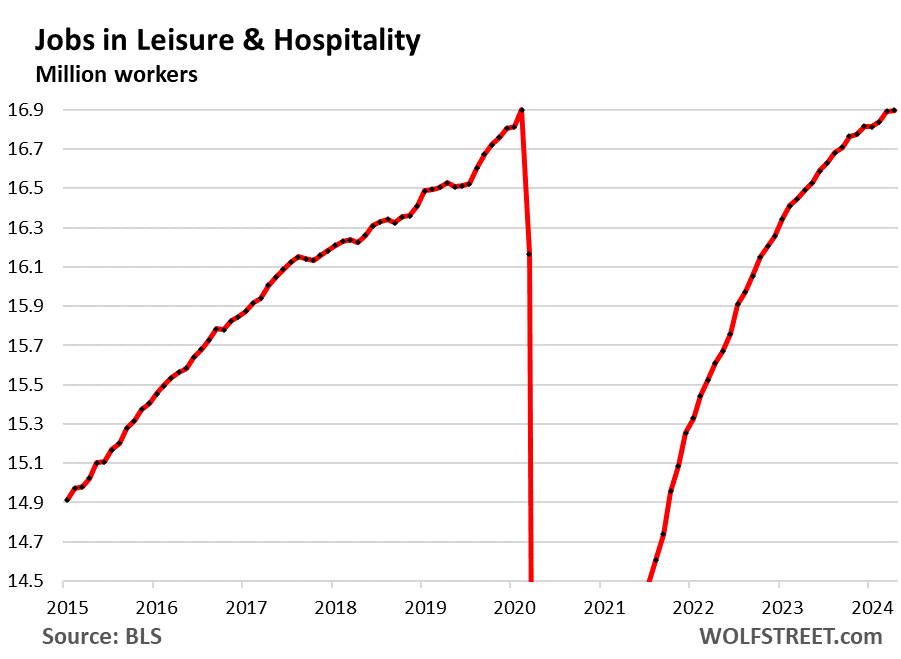
Retail trade counts workers at brick-and-mortar retail stores, such as malls, auto dealers, grocery stores, gas stations, etc., and other retail locations such as markets. It does not include the tech-related jobs of ecommerce operations, drivers, and warehouse employees.
A big portion of this sector has been under heavy pressure from ecommerce operations, and dozens of major retailers have been liquidated in bankruptcy court in recent years, with a total loss of employment, which we have documented in our Brick-and-Mortar Meltdown series. The retailers that are doing well are those that are selling groceries, auto dealers, gas stations, and others that are not under total pressure from ecommerce.
- Total employment: 15.7 million
- 3MMA growth: +20,000
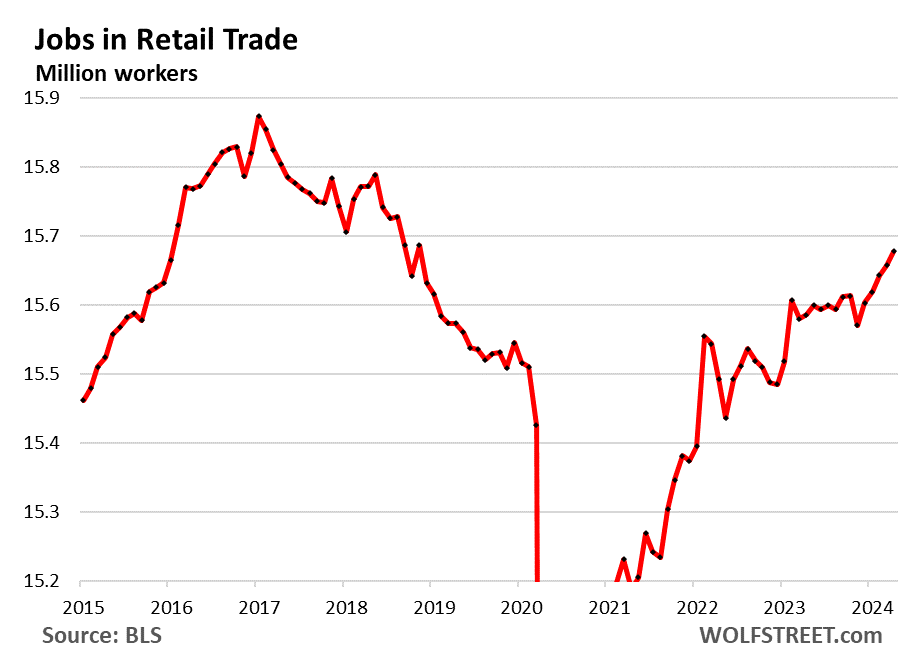
Wholesale Trade:
- Total employment: 6.17 million, new all-time high
- 3MMA: +6,000
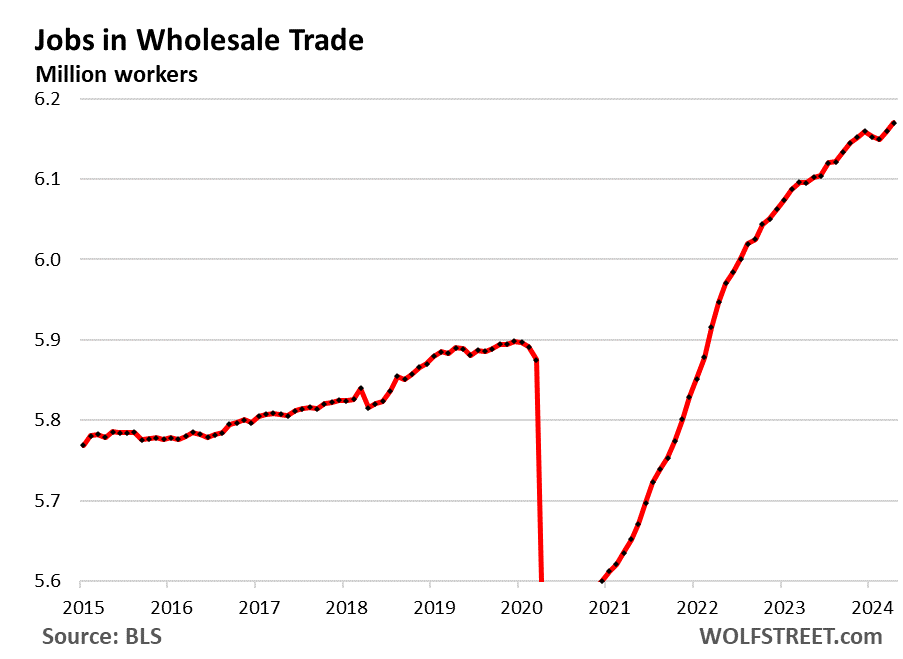
Financial activities (finance and insurance plus real estate renting, leasing, buying, selling, and management). Employment has plateaued at very high levels, as the mortgage industry got decimated after the refinance boom collapsed amid surging mortgage rates in 2021.
- Total employment: 9.23 million
- 3-MMA growth: 1,000

Transportation and Warehousing: Employment surged with the pandemic boom in durable goods, and when that faded as consumers switched back to spending on services, employment began to decline. But in recent months, it began to tick up again:
- Total employment: 6.58 million
- 3MMA growth: +20,000
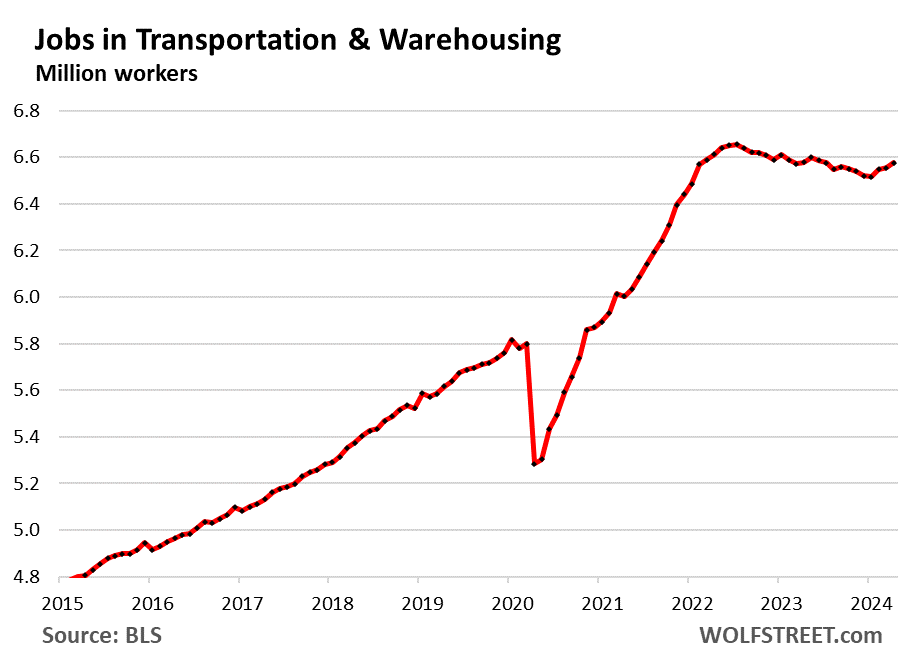
“Information” includes facilities where people primarily work on web search portals, data processing, data transmission, information services, software publishing, motion picture and sound recording, broadcasting including over the Internet, and telecommunications. This includes some work sites by tech and social media companies. You can see the effects of the layoffs.
- Total employment: 3.01 million
- 3MMA growth: -2,000
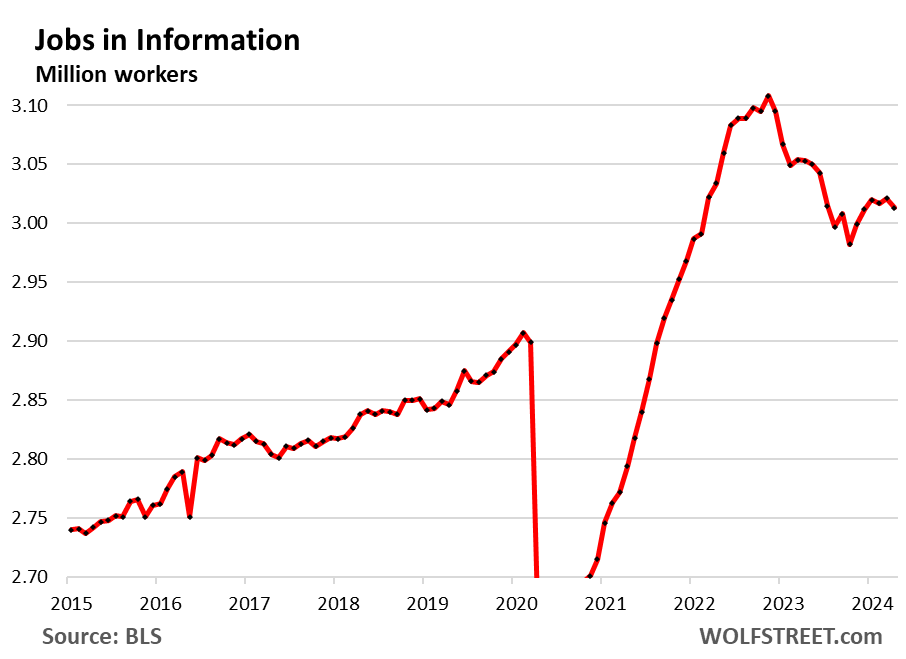
Arts, Entertainment, and Recreation includes spectator sports, performing arts, amusement, gambling, recreation, museums, historical sites, and similar:
- Total employment: 2.64 million
- 3MMA growth: +8,000

Mining, oil & gas extraction, logging: Major technological advances have impacted employment in this industry, from autonomous mining trucks to the equipment and technologies used in fracking and in logging.
And over these years, the US has become the world’s largest oil producer and largest natural gas producer.
- Total employment: 641,000
- 3MMA growth: unchanged
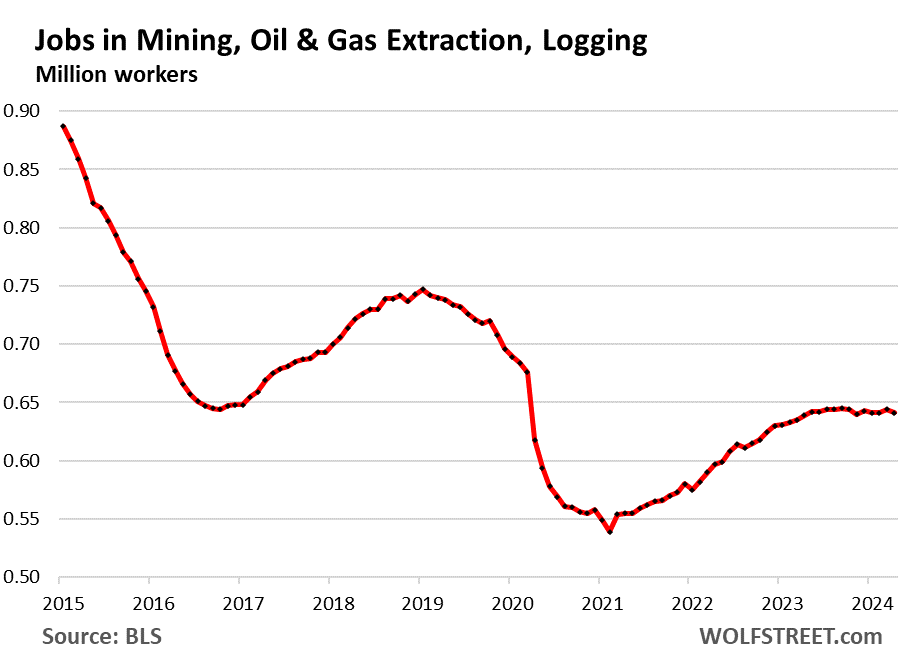
Jobs at federal, state, and local governments. About 12.8% of all civilian government employees work for the federal government. About 87.2% work for state and local governments, many of them in public education, from grade schools to universities.
As the economy and the labor market has grown over the past 15 years, government employment has also grown, but at a slower pace than overall employment, and so the percentage of government workers to overall workers has dropped and reached a multidecade low of 14.5% at the end of 2022. Since then, the percentage has ticked up to 14.7%
So this is total civilian employment at all levels of government:
- Total employment: 23.27 million
- 3MMA growth: +45,000.

And this is total government employment as a percent of total nonfarm employment. The big spikes are during the Census taken every 10 years, which in 2020 fell on the pandemic, when overall employment had plunged, and so the percentage of government employment to total nonfarm employment spiked more than normal:
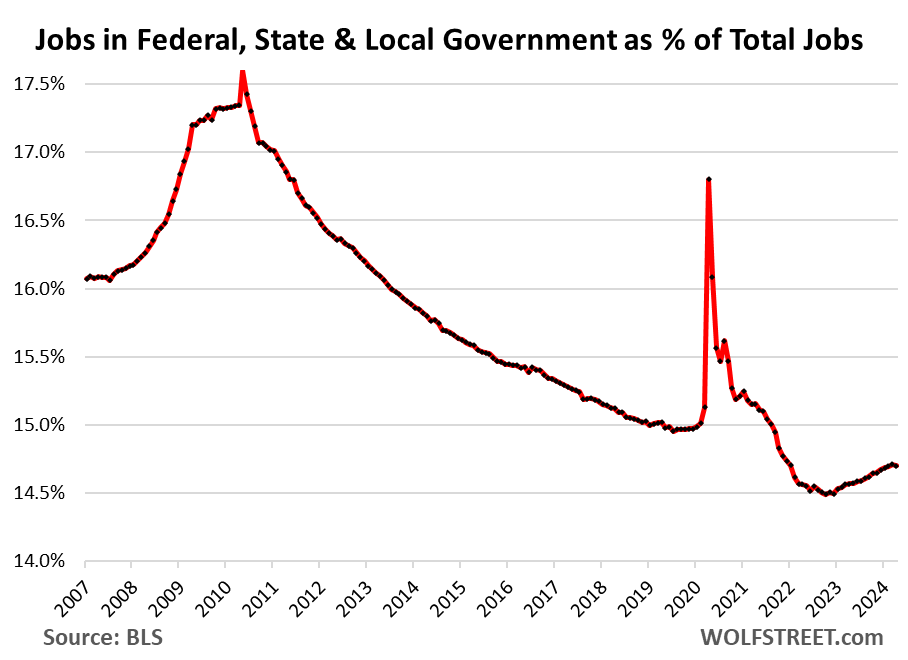
Enjoy reading WOLF STREET and want to support it? You can donate. I appreciate it immensely. Click on the mug to find out how:
![]()


Not surprised to see transportation still lagging behind a bit. I’m betting a breakdown of what jobs were transportation vs warehousing and whatnot would tell a far more interesting story.
Wages for class A truckers locally are going down or stagnating and after 70+ job applications I’ve been lucky to get 3-4 interviews. Had to take a construction job temporarily and I have a good amount of experience and a good record. Even the nightmare meat grinder jobs like food/beverage service aren’t interested. OTR companies are down to paying near their 2020 rates and have shrunk their hiring areas a lot. I know a couple guys running with an old company I used to work for who have taken 10-15% pay cuts on their mileage rates as company drivers.
The trucking world right now is an absolute bloodbath. Rates are awful, jobs are scarce and poor paying, companies are going under here and there, costs are through the roof.
Seems like IT is getting blown out of the water and trucking is tailing behind that sector. Trucking and construction can be the canary in the coal mine on a looming recession. Time will tell. Construction is going wild locally though.
Remember kids, this time is different.
This strong job market will persist as long as jobs come back out of necessity. Globalization is dead.
Globalization is not dead. I work as an engineer in the construction industry. Any non-federally funded project is being sent overseas. You need to bring back manufacturing jobs where people must show up for work and operate specialized equipment like the plants they are building in the Silicon Desert.
“Globalization is not dead”
Hilarious. Where do people get these ideas? Check out the trade deficit. Take a look at what you buy. Most stuff Americans buy is made in China.
You might have overlooked the “not”
WR,
I meant to reply to Outwest, who did say “This strong job market will persist as long as jobs come back out of necessity. Globalization is dead.”
I quoted the wrong fella, too.
That’s the theory, anyway. We’ll know how it works in practice between now and 2027.
Why 2027? What part? Or is that from “voices”, or do you hang with the Roswell bunch?
NOAA has some pretty strong “stick their neck out” predictions for 2024 summer weather. Enough to concern me, that’s for sure, I fear we are going non-linear on this climate change stuff. Maybe will wake folks up…maybe will be too late.
Side note; read today Arch-head-honcho (or whatever) Bishop of all the Philippines called for everyone to pray for rain……usually starts pouring sometime in April over there and doesn’t stop till July, so, he’ll probably get his “miracle”…a wise call….add to his creds with the Allmighty….make them more certain they will live forever, and so won’t face REAL problems…like here.
…and put more pesos in the box.
Living free for eternity CAN’T be cheap……especially after reading all the housing/inflation articles here.
NBay – grimly concur on greater climate non-linearity going forward (in no small part stemming from our initially-unwitting 200+ years of experimentation with the atmospheric chemistry). Cheap food production will be only one of the casualties (…my old trope: ‘freshwater doesn’t come from a tap, or healthy air from the sky, or food from the supermarket’. The badly-lagging general realization that reinvestment in, rather than our continued plunder, of the life-support systems of the spacecraft is necessary, continues apace…). Best to you.
may we all find a better day.
The global economy is more vibrant than ever. The US has only 4% of the global population and is increasingly insignificant in the global economy and will inevitably become less significant in the future.
Per U.S. News and World Report
2023, BY COUNTRY GDP, CURRENT PRICES IN USD
United States $26.9 trillion
China $17.7 trillion
Germany $4.4 trillion
Japan $4.2 trillion
As usual people fail to realize what our Military can do. Along with it’s global suppliers.
One would think so, rationally, but US investors (and insane funds) just increased investment in a certain, unfriendly country from 6.9% to 7.5% reportedly. It is now “cheap” like the Titanic would be if it resurfaced.
They got burned recently but are like those people long ago that decided to go skinny dipping in the river when the enormous croc, Gustav, was munching on people for breakfast, lunch, dinner, and dessert.
I found out inadvertently that my own, selected, overseas investment fund was also “skinny dipping near Gustav” so had to sell on an emergency basis. Diversifying is great but come on! I guess some people never learn or are out of ideas.
Dow screeches higher on jobs report?
This is probably the first time I’m really noticing these depraved addicts. Anything that moves sends them into a gambling frenzy,
If I had ten goats I wouldn’t be happy, I would want 15 or 20, at least, so I see…but
The odds are horribly unfavorable at this time, aren’t they?
“depraved addicts”. I doubt that addicts (humans) are affecting the movement of the major averages. It’s probably all algorithmic.
There are much fewer of those outfits than you think. I heard maybe only 4 big ones. The all use pretty much the same algorithms, so it’s all down to who can access the electronic exchange trading the fastest.
Bet you never knew microwave was faster than fiber optics!
Band width vs pure speed, ya know?
But they do account for a lot of the daily volume, I guess. No idea how much. But with free trades and no uptick rule…..shows more Congress critters are owned by PE.
People like free money, and the stock market is the best way to get it outside of government handouts. That desire will always incline the stock market to increases over decreases.
Yes, I’ve been looking at the charts, reading a few reports and some headlines from the mainstream and then coming here when Wolf does a writeup. You quickly get a very clear picture of the grift, people have massive amounts of money in play so they’ll push any narrative that might get them the result they need. As far as mainstream news is concerned the job market is so bad all of a sudden that rates can’t go up anymore, maybe even a cut is on the horizon and ofcourse it’s time to pump.. until that story doesn’t sell anymore so we’ll get something else, rinse repeat.
Honestly if I was one of those multi billion dollar hedge fund guys I’d shower Wolf with money to shut him up lol.
With the growth in healthcare, I can see why many people are realing from the cost, as most people have to pay for it.
Insurance pays for most of it, and people pay for insurance. Only about 10% of the population in the US don’t have health insurance.
7% do not have insurance as per latest stat
Thanks.
Do you have a figure for immigrants? We have about 50 million of them as of this year. I would think they are less likely to be covered/counted.
JeffD,
Immigrants are included and are counted. I’m an immigrant. I’m included. My wife is an immigrant, she is included. Both of us have been insured forever. As soon as “new” immigrants get decent jobs, they get access to insurance from their employer or in the private market. Most of them are young, and insurance in the private market is cheaper for them. Immigrants come here to work, and most of them find jobs quickly and work hard.
7% of the US population being uninsured = 23 million people. That’s still a lot. Over the past two years, the US got about 6 million net population growth through immigration (CBO number). So that’s the new immigrants. When they started working, they got access to insurance. They’re not all farm workers. Many of them are skilled and get decent jobs, some in construction, others in tech, others with meatpackers, others in services, etc. Your assertion of those “50 million immigrants” being “less likely to be covered/counted” is hogwash.
I am pondering how to interpret the structural change to the economy of the effect of the transition to e-commerce from Retail.
Let’s assume that it takes essentially the same knowledge, skills and abilities to work in Retail as in Warehousing, yet Warehouseing pays marginally better than Retail. Wouldn’t a transition from a lower-paying to a higher-paying job be a net positive for all involved?
Yes, and that is happening all the time. There is a lot of migration by individuals from lower-paying industries to higher-paying industries, including by getting additional training, education, etc. This is one of the ways people move up.
So when retail loses that worker, they have to hire a new worker, and it starts all over again.
“Wouldn’t a transition from a lower-paying to a higher-paying job be a net positive for all involved?”
When I was (much) younger I worked in some warehouses, the girls and women you see dolled up at a nice store in the mall, one of them at that time would have been my GF.. she absolutely did not want to go work in a warehouse for any amount of money lol.
Financially speaking you’re probably right though, and the next generation of mall girls will probably find something else to do to avoid warehouse work, like dance on tik tok or something else I don’t understand 😆
I worked in almost nothing but factories (same as warehouses). The girls were well exercised and generally slim and healthy, wore tight pants and t-shirts (w-w/o bra), usually had short wash and wear hair, (couldn’t even tell if they just had a roll in the sack room) swore like the guys did, and seldom played hard to get (even went after me), wore little make-up, and were just as smart as your “dolled up” retail/office Barbies.
Sounds like you missed out, pal.
About 20 of those years were at a Post Office General Mail Facility…850 people…half or more female. A total Peyton Place…ask ANY ex-PO “warehouse worker”.
NBay – times were changing (had been, slowly, in the West since Queen Vicky checked out). Have often wondered what those who were convinced they had moral-outrage Kryptonite to use against Bill Clinton thought when they discovered it was only a glowing green rock to most folks…best.
may we all find a better day.
She held on in Vancouver for a while. I remember bars in New Westminster and Vancouver that had 3 doors. Gentlemen, Ladies with Escorts, and Ladies.
Same bar ran across all three, but one DID NOT try to cross over.
Sure wish Epstien’s beans got spilled.
Wonder if a cubicle or office worker would be terrified to cross a 120K sq ft workroom floor?
That was meant for James, below, but works either place, I guess.
Some feedback from the heavy civil/highway construction side:
Record bid volumes in 2023, and on track to break that record in 2024. The same goes for revenue. Both public spending and private spending on construction are increasing and we are turning down bids. Water related construction (dams, water treatment facilities, etc.) is increasing at a faster rate than others.
The flip side is that we cannot find enough workers to build the work we win. That translates into us having to charge higher prices so we can pay higher wages to steal people from other companies. It also means we’re having to settle for less skilled workers, which then means lower productivity and/or increased re-work. We add all those factors to our prices.
Not sure how long that cycle can continue. Owners have no choice but to accept these higher prices.
“we’re having to settle for less skilled workers”.
I am a licensed carpenter along with a lot of other useless cert.s,that said,train these folks to increase/learn a new skill set and no excuses about not having the time,folks took the time to teach us.
Yep. He sounds like an office type, so he would have no idea about the job…..other than what his “human resources” cost him and what he thinks is “why”.
I got a good laugh over the “re-work” part…..hope he got in trouble for it as a “bad” manager.
The JOB is ALWAYS the ultimate authority……not some suit.
how can it be that we have a huge influx of immigrants and you can’t find workers?
WIZ – suspect it could be ‘cheap’ inserted in front of ‘workers’, and, no matter the times, never ‘cheap’ enough…
may we all find a better day.
So over the last 6-12 months jobs are pretty much growing, plateauing or declining slightly. Sounds like a goodly strong labor market to me.
Oh, and where are 1st-time unemployment & continued unemployment claims? low 200Ks & sub 1.8M, both of which do not spell any sort of near-term trouble for the labor market.
175K jobs isn’t bad & at sub 4% unemployment, job gains are at the margins. The latest data shows we’ve been sub 4% for 27 straight months which beats some very old records.
No big pressure to cut or raise. Higher for longer, JPowell!
Great article! Fantastic work as usual, Wolf. Thanks.
Working is so 1999!
All one needs to do is go online at one of these “instant cash” sites and you can get money sent to your bank account with the click of your mouse! I see these offers all the time on TV. What a great country we live in!
I’ll bet even Bubba would agree!
Bubba, aka ((squirrel) would be glad your on his mind.
Robotics is the best, soon I can save 80-90% off of my dentist costs when the robots come to town. These greedy human dentist care only about making money, where’s a robot would give love and kindness along with a gentle touch.
May the 4th be with you all.
………and, so, this once “proper and ordered” world has gone to hell, yes?
I’m the same age as you and evidently missed that whole thing.
Interesting to see which industry employment levels is currently trending above or below the pre-COVID trends. These trends are very telling.
Some example:
Healthcare trending (i.e., higher slope) is much higher now than pre-COVID.
Construction is trending the same (i.e., same slope) but at a lower offset.
Professional services employment is comparable to pre-COVID, but is trending lower (smaller slope) than pre-COVID.
More Healthcare employment has been expected for 20 years based on the demographics of the US’ aging population; it shouldn’t surprise anyone.
Thanks for plotting the series and putting them in one place!
RE: “Manufacturing has continued to automate, requiring fewer but higher-skilled workers, including engineers.”
I’m a bit skeptical its happening to a very large degree because I have the sense that labor productivity numbers aren’t really telling this story, and I’m also concerned about what kind of automation we’re talking about. If it’s automation that could have been done long before but wasn’t because of competitive pressures, but now is done and becomes too widespread, it might actually hinder differentiation and innovation, potentially causing more harm than good on an aggregate level.
In technology, simplicity is the ultimate sophistication.
If a part of a system offends thee, remove it.
Twas probably over-engineered, anyway.
Financial services may go down with the new agreement that sellers don’t pay a buyer’s agent commission. It just won’t be lucrative enough to maybe get $1k from the buyer for your work when you show them 2 dozen houses just to find 1.